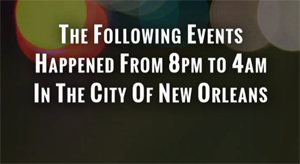By Dave Konig
“In the city of New Orleans there are as many as 1,000 emergency calls every night. These are the stories of the heroes who risk their lives to answer those calls. Police officers, firefighters, and emergency medical technicians. This is Nightwatch.” — A&E narrator during opening credits.
“A lot of skeevy things happen in the night. A lot of scary things happen in the night,” explains Paramedic Holly Monteleone (@NightwatchHolly) after the introduction to A&E’s new series Nightwatch. The show attempts to reveal the skeevy and scary things she mentions by following representatives of the three branches of emergency service – EMS, fire, and police- during the hours of 8 p.m. to 4 a.m. through New Orleans, Louisiana.

NOLA EMS en route to GSW
The first segment focuses on the shooting of Anthony Woodberry. Holly and her partner Gavin respond to the call along with a second unit of paramedics, Titus Tero (@TeroTitus) and Dan Flynn (@Nightwatch_Dan).
Dan is quick to point out to his partner that they may beat Holly and Gavin to the call, “depending on how you drive,” to which Titus gives a chuckle before lamenting about how this may just be one gunshot victim, but what they really have to be concerned about is the retaliation that will unfold from the one incident. The episode is titled “Retaliation,” so the viewer has a good idea that this is just foreshadowing for the rest of the episode.
Once on scene the camera angles capture the chaos relative to loading a gunshot victim onto a stretcher and into the back of the ambulance on an unsecure scene. What Nightwatch excels at over its predecessors is the use of a hard mounted overhead camera position in the rear of the ambulance focusing on the stretcher and, therefore, the patient on it. This overhead provides the viewer with a dramatic birds-eye-view as the four paramedics work to prevent Woodberry from slipping away and Holly narrates over the scene expounding on the teamwork required in EMS. “You want a flow and we naturally have a flow. It’s like a little orchestra,” Woodberry says as IV lines are established, occlusive dressings applied, oxygen is administered, and needle decompression is performed.
 Law enforcement investigation of GSW
Law enforcement investigation of GSW
Once the ambulance doors close and the transport is underway, the series transitions to the law enforcement investigation of the shooting scene. Officer Victor Grant uses his flashlight to illuminate the number of items that Woodberry bled on, including a garbage can and the door of a pick-up truck. He and his partner Cedric quite literally follow the trail of blood left to identify where the actual shooting took place, which is around the block from where Woodberry was found. The first segment concludes by switching to the back of the ambulance where Holly has given a report and is attempting to help the doctor on board intubate the victim.
Opening sequence is strong start
The first segment is a great indication of the rest of the episode which delivers three more EMS-centric assignments; a man with shortness of breath, an intoxicated man with a badly lacerated hand, and a geriatric female gunshot victim. Nightwatch also illustrates law enforcement’s “wolf pack” patrol technique, and throws in a potential arson fire where firefighters administer oxygen to a feline suffering from smoke inhalation.
 Crisp audio and fast editing cuts
Crisp audio and fast editing cuts
While gunshot victims deliver a high level of excitement for the providers and for the viewers, I give Nightwatch credit for how they portrayed Titus and Dan responding to and treating a patient with shortness of breath. The clear audio and fast cuts interspersed with Dan’s sit-down interview further explaining the patient’s condition made the repetitive assignment, along with the application of CPAP, just as fast paced and exciting as a trauma.
This series promises to be both an exciting and educational show for the general audience and EMS providers alike. While it looks like future episodes will cover all three branches of first responders, the premiere episode definitely shined the spotlight on the EMS providers of the Crescent City … and they looked great.
Positive and realistic portrayal of EMS
Too often we find ourselves, as EMS providers, being overly critical whenever EMS is given wide exposure. I myself am quick to complain (usually on Twitter) about every time an EMS crew brings a stretcher ringside on a wrestling show without a sheet over the mattress. Were there things I’d like to have seen differently on Nightwatch? Sure there is, but complaining about them not wearing their seatbelts or any of the other miniscule things I noted should not prevent us from celebrating their overly positive and the mostly realistic portrayal of our profession to the people whose opinions matter the most – the general public whom we all serve.
Should the video and audio presentation seem familiar to you, most notably the beginning narration and some of the voiceovers, there is a good explanation. Nightwatch is executive produced by Dick Wolf who also has writer and producer credits for Law & Order – a show that premiered in 1990 and continues to go strong), – Chicago Fire, and Hill Street Blues. If Nightwatch is only half as successful as those other shows, we can look forward to many seasons of EMS action in the Big Easy.
Nightwatch is broadcast on the A&E Network Thursday nights, check your local listings for times or stream full episodes online.
About the Author
Dave Konig has been an EMS provider since 1994, starting as a volunteer in his local squad. Since 1995 he has been working as a career provider, supervisor, manager, and director overseeing ambulance operations, communication centers, and most recently large scale special event EMS. He is the author of The Social Medic blog as well as the founder and administrator for the EMSBlogs.com network. You can reach him at dave@emsblogs.com or on Twitter @DavidKonig











